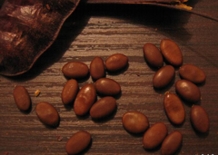| Perennial / Evergreen Trees / Carob Tree (Ceratonia siliqua) - Chocolate Tree |
|
|
|
|
| |
|
Plant name - Carob
|

|
|
 |
|
 |
| Common name - Chocolate Tree
|
| Plant type - Evergreen |
| Vegetation type -
Perennial |
| Growth rate - Medium |
| Leaf / Flower color
- Green / White |
| Other names - Ceratonia siliqua
|
| |
| Description : |
Ceratonia siliqua, commonly known as the carob tree, St John's-bread, or locust bean (not to be confused with the African locust bean) is a species of flowering evergreen shrub or tree in the pea family, Fabaceae. It is widely cultivated for its edible pods, and as an ornamental tree in gardens.
The ripe, dried pod is often ground to carob powder which is used as a substitute for cocoa powder.
It is native to the Mediterranean region including Southern Europe, Northern Africa, the larger Mediterranean islands; to the Levant and Middle-East of Western Asia into Iran; and to the Canary Islands and Macaronesia. The word carat, a unit of mass for gemstones and a unit of purity for gold alloys, was possibly derived from the Greek word kerátion literally meaning a small horn, and refers to the carob seed as a unit of weight.
.
|
| |
| Growing Instructions : |
* Rub dried carob seeds between two pieces of sand paper or nick the surface with a sharp knife. Place the seeds in a bowl of water until they swell to about three times their previous size.
* Fill a 12-inch-deep pot with sterile seed-starting medium such as vermiculite or a sterile, soil-less premixed formula designed for seed germination. Use a pot that has several drainage holes in the bottom.
* Make a 2-inch-deep hole in the center of the pot. Drop the seed into the hole and cover it with 2 inches of potting mix. Plant seeds in the fall or spring. Keep them in a greenhouse for the first year. Keep the soil damp but not saturated during germination and first year of growth.
* Transplant the carob sapling outside to a permanent position if the climate is suitable. Transplant in the the spring, one year after germination. In colder areas, transplant the seeds into a deep pot. Keep the tree in a greenhouse or protected area during the winter. Use a pot that is at least 4 feet deep to accommodate the long tap root.
* Keep the soil damp around the sapling for the first year. In hot dry weather, water daily or every other day. In cool damp weather, watering may be not be necessary. Apply water when the top 2 to 3 inches of soil feels dry. Mature trees need water only in severe drought.
|
| |
|
|
|
|
|
